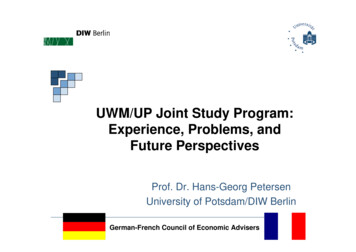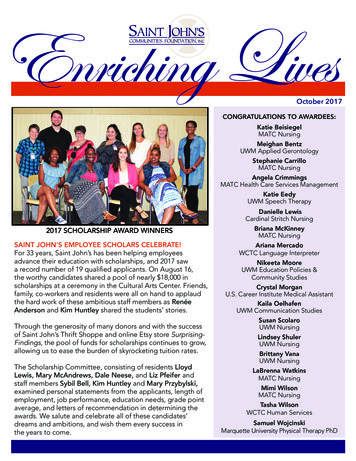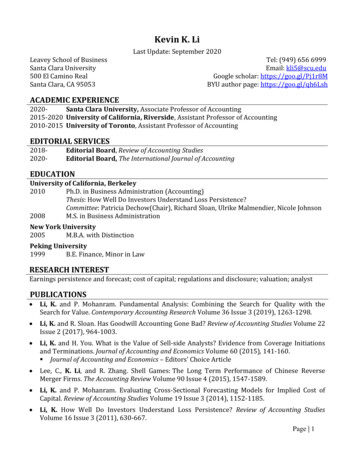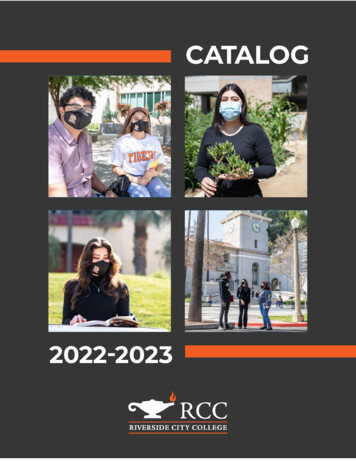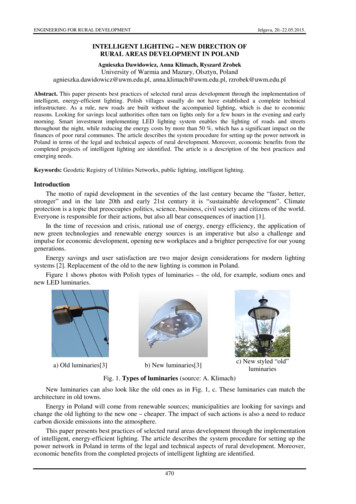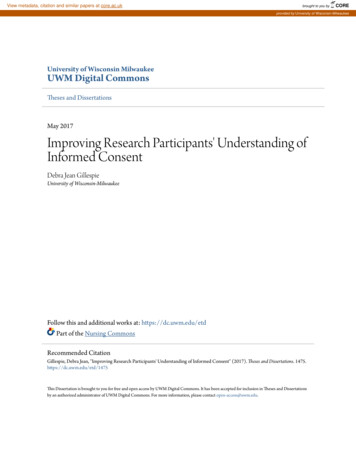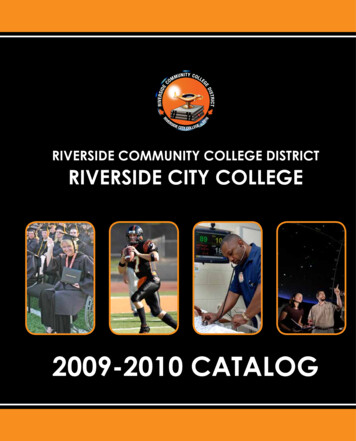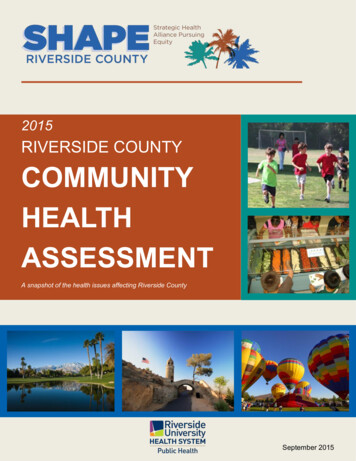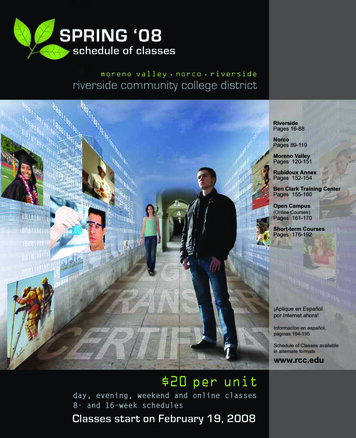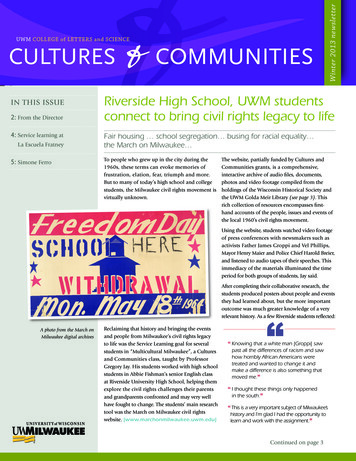
Transcription
Winter 2013 newsletterUWM COLLEGE of LETTERS and SCIENCEIN THIS ISSUE2: From the Director4: S ervice learning atLa Escuela Fratney5: Simone FerroRiverside High School, UWM studentsconnect to bring civil rights legacy to lifeFair housing school segregation busing for racial equality the March on Milwaukee To people who grew up in the city during the1960s, these terms can evoke memories offrustration, elation, fear, triumph and more.But to many of today’s high school and collegestudents, the Milwaukee civil rights movement isvirtually unknown.The website, partially funded by Cultures andCommunities grants, is a comprehensive,interactive archive of audio files, documents,photos and video footage compiled from theholdings of the Wisconsin Historical Society andthe UWM Golda Meir Library (see page 3). Thisrich collection of resources encompasses firsthand accounts of the people, issues and events ofthe local 1960’s civil rights movement.Using the website, students watched video footageof press conferences with newsmakers such asactivists Father James Groppi and Vel Phillips,Mayor Henry Maier and Police Chief Harold Breier,and listened to audio tapes of their speeches. Thisimmediacy of the materials illuminated the timeperiod for both groups of students, Jay said.After completing their collaborative research, thestudents produced posters about people and eventsthey had learned about, but the more importantoutcome was much greater knowledge of a veryrelevant history. As a few Riverside students reflected:A photo from the March onMilwaukee digital archivesReclaiming that history and bringing the eventsand people from Milwaukee’s civil rights legacyto life was the Service Learning goal for severalstudents in “Multicultural Milwaukee”, a Culturesand Communities class, taught by ProfessorGregory Jay. His students worked with high schoolstudents in Abbie Fishman’s senior English classat Riverside University High School, helping themexplore the civil rights challenges their parentsand grandparents confronted and may very wellhave fought to change. The students’ main researchtool was the March on Milwaukee civil rightswebsite. [www.marchonmilwaukee.uwm.edu]“ Knowing that a white man [Groppi] sawpast all the differences of racism and sawhow horribly African Americans weretreated and wanted to change it andmake a difference is also something thatmoved me.”“ I thought these things only happenedin the south.”“ This is a very important subject of Milwaukee’shistory and I’m glad I had the opportunity tolearn and work with the assignment.”Continued on page 3
FROM THE DIRECTOR:Greg JayWhat’s aCCBLLR?This may be anunwieldy acronym , but it represents a newand streamlined approach to communityengagement at UWM—one that will createmore opportunities for students, faculty andstaff to make a difference in Milwaukee.January 2013 brought the opening ofUWM’s innovative Center for CommunityBased Learning, Leadership, and Research.Located in the UWM Student Union,the Center merges the former Center forVolunteerism and Student Leadership withthe Institute for Service Learning, whichwas formerly housed within Cultures andCommunities. This restructuring will createa “one-stop shop” for academic communityengagement at UWM, making it easier forstudents to find the experience that best fitstheir learning goals and career ambitions.Dr. Laurie Marks,Center Director,explains, “Thenew Center willprovide more opportunity for studentsand faculty to engage in the Milwaukeecommunity through partnerships withMilwaukee’s non-profit organizations,while also creating a more visible cultureof engagement and a network of engagedscholars and students on campus. Over thenext two years we will be exploring howbest to organize the activities of the Centerand what key priorities it will focus on.”Cultures and Communities students andfaculty will still work closely with theService Learning office, now relocated tothe Center’s expanded space in UnionWG28. Service Learning students will findthere information on how to continuewith their community-based learningonce the semester ends, connecting with Dr. Laurie Marks, CCBLLR Directorother organizations and agencies or evenarranging to stay with the one from theirclass. Students who come into the Centerto volunteer will see that they may also getacademic credit in the future by signing upfor a Service Learning course.The volunteer and leadership programs atthe Center will be better coordinated withthe Cultures and Communities CertificateProgram. Community partners will findit easier to collaborate with UWM, since asingle phone call will get them informationon a variety of options for finding resourcesand working together. Faculty who teachcommunity-engaged courses will discovera strengthened and expanded structure ofsupport for instructional activities. Researchshows that students who are active incommunity engagement and in leadershipprograms express more satisfaction withtheir college education and improve theiracademic outcomes.Greg Jay(gjay@uwm.edu)Mexican immigration, health subjectof Tenorio presentationUWM’s Cultures and Communities(C&C) Program is committed to fosteringcivic engagement and scholarship bysupporting all staff as they pursueprofessional development opportunities.Last spring, C&C staff member andMulticultural America 150 instructorRamona Tenorio presented at the conference¡Salud! Beyond Deficits and Paradoxes inMexican Immigration and Health, sponsoredby the City University of New York Institutefor Mexican Studies at Lehman College. APh.D. candidate in Anthropology, Tenorioresearches transnational socio-medicalnetworking and healing practices amongdiasporic Latinos in the U.S.She joined other nationally recognizedexperts on Mexican immigration and healthto explore the health disadvantages and2advantages of the U.S. Mexican population.One of the goals of the conference was tobreak new ground in research and analysisin those areas.Tenorio is interested in understandinghow socio-medical networks are formedand maintained. Such networks allowfor the transnational flow of personnel,equipment, and supplies to support layhealing traditions under the radar of theU.S. biomedical health care system.“Without the financial support from theCultures and Communities Program,attending the conference would nothave been possible,” she said. “At theconference, I was able to engage at thepublic policy level with local and nationalleaders on immigration and health.”
Riverside High School continuedAssignments for Jay’s students included finding and analyzingprimary sources like letters sent to Groppi, some of which werecritical of a priest taking on the role of a civil rights activist. Afteridentifying materials that interested them, the students were askedto reflect in writing, and orally, on the issues involved. “Learningto work with primary documents in Milwaukee’s history empowerspeople to have their own opinions,” Jay said.For some UWM students, the visits to Riverside University HighSchool were their first direct exposure to cultural diversity. Asstudent Nicole Hutchins commented:“ The experience that I have had at Riverside High has givenme a different perspective on the cultural differences in theinner-city school. The first thought I had going into theschool was the feeling of being a minority. In my life, I havealways been in the dominant culture, but when I steppedinto Riverside for the first time, it was obviously not thecase. I did not feel comfortable or uncomfortable. It was justvery different from what I have grown up with and what Ihave always been used to.”Here is UWM student Karli Bryant’s take on the project:“ The first day we were put into groups (with the RiversideHigh School students), the conversation was forced and themeeting was awkward. However, after a few conversationswith my group we blend well and have conversations thatinform me of their city and their life. With the talk we hadabout the housing in Milwaukee, I was better introduced tothe neighborhoods here. I enjoyed learning about their livesoutside of school and being raised in an urban area andhow that differs from my upbringing.”Fishman’s high school students also attended a session of Jay’sclass on the UWM campus, which focused on exploring thequestion, “What is social justice?”Moved by what they learned throughout their work with the UWMclass, the Riverside students composed letters to President Obamanominating Groppi and Phillips for the Medal of Freedom.The UWM students also read and discussed poems from MargaretRozga’s book 200 Nights and One Day. Rozga is Groppi’s widowfrom after he left the Catholic priesthood. Once the UWM studentswere familiar with the website and the poems, they shared theirinsights with their cohorts at Riverside. Jay said there was a“vocabulary gap” between the UWM and Riverside students – thehigh school kids didn’t always understand words like “boycott”and “sit-in” because such social and racial history isn’t taught ingeneral social studies classes in public schools.Father James Groppi, civil rights activist The March on Milwaukee Civil Rights History Websitesupports understanding of the struggle for racial equalityby helping users discover primary sources and other educationalmaterials from the collections of the University of WisconsinMilwaukee Libraries and the Wisconsin Historical Society.The digital collection includes the papers of individualsrepresenting a variety of positions on the civil rights issue,photographs, unedited footage from news film archives,and oral history interviews capturing the recollections andperspectives of individuals who participated in the movement.organizations; a timeline; a bibliography of relevant publishedsources; and maps highlighting important locations.The collection also includes contextual materials, such asbrief explanations of relevant people, places, events, andwww.marchonmilwaukee.uwm.eduThe materials reproduced in this digital collection are only aselection of the primary sources documenting Milwaukee’s civilrights history held by UWM and the Wisconsin Historical Society.3
Learning about culturalidentity from some veryyoung teachers“What am I thinking? I thought to myself as Idrove to La Escuela Fratney that Wednesdaymorning. I really do love kids, but it’s not likeI am responsible to any. Now I have to beresponsible to some kids I never even met.What If they don’t like me?”But Dan, who was worried that the kids might not accept himbecause of racial or cultural differences, needn’t have been. Astudent in Melissa Schoeffel’s Cultures and Communities Englishclass, he and his classmates were welcomed by the K-5, first-gradeand second-grade children they would be working with for theirService Learning assignment.children don’t necessarily categorize in the way an older child oradult might,” Schoeffel said. “They don’t as much have culturalbaggage yet.”Last spring, Schoeffel, a senior lecturer in English at UWM,proposed the idea of her students connecting with youngsters at theschool on a storytelling project. La Escuela Fratney is a MilwaukeePublic Dual Language School. The school focuses on social justiceand offers a curriculum “designed to meet the needs of younglearners preparing for life in a multicultural, multiracial society”—aperfect fit for a Cultures and Communities class.The UWM students found that when the children talked about eachother, they didn’t talk about appearance: they talked about playingwith each other. As Teresa put it, “These kids don’t care what youlook like, who you are or where you come from. All they care aboutis who is going to share their crayons or who is going to play armywith them later.” Many were also impressed that the children couldthink and speak so fluently in more than one language.Both groups of students benefited from the project—the UWMstudents learned first-hand about how identity and attitudes towardsimilarities and differences between people develop. The Fratneystudents got a chance to work with older “buddies” on a videoproject that allowed them to share their stories and see themselvesstarring in a video. The experience also gave Schoeffel’s studentsan opportunity to navigate in a new environment, since they oftencome from non-diverse communities and schools.Schoeffel said the experience helped her students break downstereotypes and confront their feelings. Some went in with fears,particularly those who had grown up in very different types ofcommunities. “They walk into the school a lot of times with aheightened sense of their own privilege; walking into what theyunderstand to be a diverse setting. They’re more nervous ‘I haveto go to this “inner city” school and who knows what’s going tohappen.’ “They came away with a greater understanding aboutmany issues of multicultural diversity, including privilege and howit relates to cultural identity, she said.The UWM students were challenged to think about storytellingin the context of multicultural America. And what better way toexplore storytelling than with young children! Students workedwith small groups of children to write personal stories and to thinkabout the different facets of storytelling, including why we tellstories, what they say about our lives and the people around us,how a story progresses, and what makes a story memorable.Each session at La Escuela Fratney had an established goal for theUWM students, but many felt they accomplished much more thanthe syllabus prescribed: “Throughout this experience, though veryshort, I feel as if I’ve only gained, “ said one of Schoeffel’s students,Teresa. “I was the only white person in my group. I didn’t mind thisat all because I got to listen to their stories of how they grow up athome and I loved every second of it.”Students were encouraged to stimulate conversations among theyoung kids about what makes us all alike and different. “Young4After several sessions with the kids, the UWM students returnedto La Escuela Fratney to share the digital stories they compiledfrom photos, drawings and interviews collected from their youngpartners. This experience, more than anything, forged memories ofrelationships that will last long after the course grades are in or thestories themselves are forgotten.Said Dan, “I don’t think the kids thought I was privileged because Iwas white, but I was [privileged] because I got to share their time! Ileft a lot at the doors of the school, mostly fear (of the unknown).What a ride it has been. From wondering what the heck I was doingto looking forward to being with these kids has been a trip I am sograteful for taking.”
CUP grants build relationships with community partnersBuilding collaboration between campus and community is a mainstay of theCultures and Communities Program, and perhaps is nowhere more evident than inthe work made possible by our Community University Partnership (CUP) grants.Congratulations to the 2012-2013CUP Grant Award Winners!Community organizations and UWM groups are invited to apply for the 2013-14CUP grant competition. The grants support limited term projects and events thatpromote partnerships between UWM and the diverse communities it serves.Having Our Say: Healthier Homes and Babies– Dalvery Blackwell, African American BreastfeedingNetwork of Milwaukee and Betty Koepsel, UWMCollege of NursingSince 1999, over 65 CUP grants have been awarded for projects that span thedisciplines and reach into many of Milwaukee’s neighborhoods. CUP grantcollaborations emphasize cross cultural literacy, local/global perspectives onsocial and artistic issues, the relationships of science to culture and society,environmental initiatives, gender issues, community development, immigrationissues and religious pluralism. They also offer service learning and other communityengagement opportunities to UWM students.All applications that meet grant criteria will be considered, however funding prioritywill be given to those which work toward creating healthy communities in the Cityof Milwaukee. For example, projects may address such issues as health disparities,healthy aging and improvements in quality of life which respect the environment.An informational workshop will be held on Tuesday, April 2, from 10-11:30a.m. in Room 320 of the UWM Union, 220 East Kenwood Boulevard and onWednesday, April 10 from 1-2:30 p.m. at the Nonprofit Center of Milwaukee,2819 W. Highland Boulevard. Registration is requested and is available onlinewww.cup.uwm.edu/informationsessions.cfmFor more on the grants, including guidelines and an archive of awardees,visit www.cup.uwm.edu, or contact Dr. Cheryl Ajirotutu, 414-229-5960;yinka@uwm.edu.The Roots of the Islamophobia Network in theUnited States – Janan Najeeb, Milwaukee MuslimWomen’s Coalition and Abbas Sarour, UWM MuslimStudents AssociationTranslating the Evidence-Based Chronic DiseaseSelf-Management Program into CommunityAction and Community Based Capacity Building– Patricia McManus, Black Health Coalition ofWisconsin, Inc. and Fang (Alice) Yan, UWMDepartment of Community and Behavioral HealthPromotionHmong Women’s Conference on HistoricalTrauma – MayTong Chang, Hmong AmericanWomen’s Association and la Xiong, UWMCounseling Psychology Student AssociationCULTURE Club: Cultural Understanding andLeadership Training United in Real-worldEnvironmentalism – Jamie Ferschinger, UrbanEcology Center and Ms. Dana Kaleta, UWM QuestProject; Trio and PreCollege Programs(Re)generating American Indian PartnershipsBetween Home and School – Amy Tromp, IndianCommunity School of Milwaukee and Jeremy Garcia,UWM Department of Curriculum and InstructionJourney House Lego Robotics Program – CheriseMeyers, Journey House and Maria Hamlin, UWMSchool of EducationConnecting University Students with theMilwaukee River Greenway Coaltion – AnnBrummitt, Milwaukee River Greenway Coalition andRyan Holifield, UWM Department of GeographyFor more on all of the projects, go towww.cup.uwm.eduMiddle school children participate in the Journey HouseLEGO Robotics program with UWM student mentors.The project is a CUP grant recipient.5
Choreographingnew steps incommunityengagement“ UWM is a place where I found aterrain.to develop myself as ahuman being, as a mentor, as achoreographer, as an artist. Theimprint and the legacy that UWMhas are cherished by this community."- Simone FerroSince its inception more than a decade ago, Cultures andCommunities has been collaborating to build a diverse andengaged faculty and has been instrumental in bringing innovatorslike Simone Ferro to campus.Ferro, now chair of the Department of Dance in the Peck Schoolof the Arts, came to UWM in 2001 with performance credentialsfrom all over the world. A native of São Paulo, Brazil, she had adistinguished professional career as a soloist with dance companiesin Brazil and Switzerland before completing graduate work indance at the University of Iowa.She has collaborated extensively with local dance, theater andopera companies and is a strong advocate for Milwaukee and theMidwestern dance community.Her dance pieces–often dealing with racism, women’s identity,alienation, and community identity–provide both artistic andpedagogical engagement of dancers in broad social themes. Since2004, Ferro has travelled regularly to Brazil with her husband andresearch partner, Meredith W. Watts, to document and research thetraditional Bumba-meu-boi folk festivities in the Northeastern stateof Maranhão.“We brought a remarkable person here with perspectives on globaldance and the arts,” said Greg Jay, director of the Cultures andCommunities Program. “She has embodied many of our goals,including creating interdisciplinary collaborations across campusand advancing community engaged scholarship.”Working with formerdance department chairMarcia Parsons, Ferrohelped develop andfor many years taught“Rituals and Cultures”, a non-performance classwhich enlarged general education requirement offerings in dance.She also helped to create a position in world dance.In a stand-out partnership, documented in the spring, 2012issue of the Michigan Journal of Community Service Learning,Ferro worked with the Walnut Way Conservation Corporation, tocreate dances based on oral histories gathered from neighborhoodresidents. Their stories were collected by UWM anthropology studentsunder the supervision of Cheryl Ajirotutu, an associate professorin Anthropology who is also associate director of Cultures andCommunities. The collection of the histories themselves was anelement in a larger, multi-year partnership between UWM and WalnutWay that focused on broad efforts to reclaim the neighborhood’svibrant history and culture.Ferro’s work was performed by her UWM students at the WalnutWay community center as well as at several local schools and oncampus. “What evolved,” wrote Ferro in the article on the project,“was a rich multigenerational, multiracial interaction betweendances and the community members whose stories were expressedthrough dance.”Photo Caption: UWM dance students perform a work choreographed bySimone Ferro. The work was based on stories of migration to Milwaukee toldby residents of the Walnut Way neighborhood.Simone Ferro, Chair, Department of Dance, Peck School of the ArtsPhotos by Meredith WattsContact Cultures & CommunitiesCultures & CommunitiesTel: 414-299-5960UW–Milwaukeeuwm.edu/ccHolton Hall G362442 East Hartford Ave.Deborah Fagan, Editor dfagan@uwm.eduMilwaukee, WI 53211
Fair housing school segregation busing for racial equality the March on Milwaukee To people who grew up in the city during the 1960s, these terms can evoke memories of frustration, elation, fear, triumph and more. But to many of today's high school and college students, the Milwaukee civil rights movement is virtually unknown.
